| |
|
This
precious little church sits on a rise beside the
busy Ixworth to
Thetford road. If it wasn't for the little
bellcote you might think it a barn or farmhouse,
and pass by without a second glance. The roofline
is memorable and attractive, the way the thatch
covers over the transition between nave and
chancel as if it was melting over them like soft
cheese. The porch seems very extravagant for such
a homely building, and is among Suffolk's best
red-brick Tudor porches. It is so large inside
that it is not hard to imagine its use for parish
business. If you want to see inside All
Saints, you'll need to get the key from the farm
office across the road. It is only available on
weekdays, unfortunately, not much help if you
work full-time. A rather flustered lady who gave
it to me advised me "not to hurry, I've got
to work out how to turn the burglar alarm
off."
Peter
and I pottered back up the hill and let ourselves
in, expecting bells to sound at any moment, and
Suffolk's Finest to arrive and feel our collars.
But none of this happened. Instead, we stepped
into the silence of a small country church which
has not changed much in a hundred years; apart
from the burglar alarm, of course. I remembered
coming here some eight years previously, and
there was the same sense of dust falling slowly
through the air, as if the blacksmith and the
ploughboy had just stepped outside for a moment.
The
Victorians restored well the sacramental
integrity of the building, and you face east
through narrow benches and boxes towards the
three-sided 17th century communion rails, altar and east
window above. Because of the low roof, and the
lack of aisles and clerestory, this can
be a dark interior on a gloomy day. Best to come
here when the sun is shining, and the body of the
church is filled with light. Thus illuminated,
the bench ends come to life, and this is what
Ixworth Thorpe is famous for.
They are part of the same nationally
important group as nearby Stowlangtoft and Honington. Most
memorable is the figure variously described as a
harvester and a thatcher. I think he is the
latter. What a lovely example of 15th century
East Anglian folk art! Nearby, a lady takes her
lapdog for a walk, and a mermaid holds a mirror.
Among the beasts are a unicorn, a horse and a
hare. There is an owl to the west, and, I think,
a cockatrice, who, unlike his twin in the chancel
at Honington, retains
his comb.The figures are attached to 19th century
benches, and some of them are one-sided,
suggesting that they were once against walls.
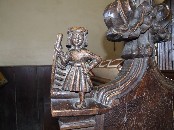 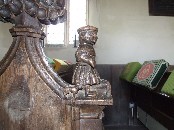
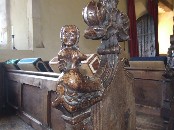 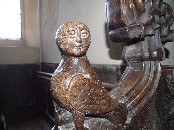
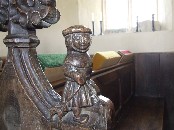
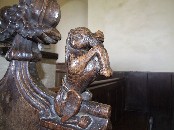 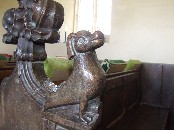 
The tiny 18th century pulpit has the
familiar archway carvings, a contrast to the
Victorian readers desk in the chancel, in the
form of a fierce, lifesize eagle. Mortlock though
it originally had a secular use. On the chancel
wall hangs a table of matrimonial laws, which all
churches had at one time. This would originally
have hung in the porch, but under the guise of curiosa,
has moved into the church. The simple little war
memorial plaque is the work of Morris & Co. A
George III royal arms looks down imperiously from
above the tower arch.
Everything
is simple, but lovely. This is a wholly rustic
space, at the heart of the fields and copses
round about. There is no Ixworth Thorpe village
really, and this scattered parish could not help
but see its church on the hill as a focus of its
identity. Inevitably then, it is a church of the
ordinary people, with a sense of their
continuity, and of its place in their community.
It is little known, but should be celebrated. If
only it was easier to visit!
|
|
|

